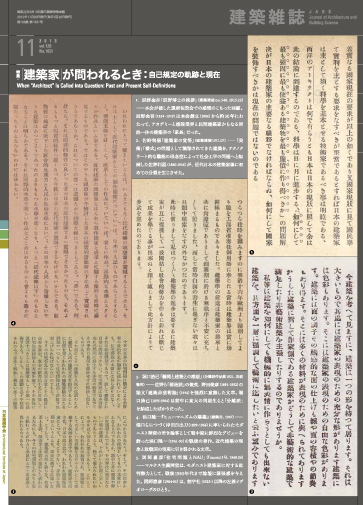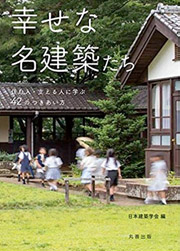本文PDFの閲覧につきましては、こちらでご確認ください。

2013-11月号 NOVEMBER
特集= 「建築家」が問われるとき
─自己規定の軌跡と現在
When “Architect” Is Called into Question─Past and Present Self-Definitions
特集前言 建築家とは何か―問いは繰り返される
試しに「建築家」をタイトルに冠した書籍を検索してみよう。2000年前後からの急増に気付くだろう。20世紀の巨匠たちの歴史化が進みつつあることと、同時に従来の建築家像への反省や疑問とともに、新たな建築家像の模索が進みつつあることの現れだろう。「3.11」は、そうした模索の線上に、「建築家─社会」の関係を取り戻す、というある意味で素朴な問いを顕在化させている。
こうした揺れや問いは、いろいろな歴史的脈絡を想起させる。建築家と社会、という議論が今に始まったことではないことは明らかだ。戦前からの左派の系譜があるし、戦後派のモダニスト建築家たちのなかにも現実の都市・土地あるいは社会・制度と格闘した人々がいる。具体的な地域社会に根ざし、多様な課題に取り組む建築家像も、1970年前後から出現する。ヒロイックな固有名を消す共同設計の試みも、戦後間もなくの時期から伏流する鉱脈のひとつだ。しかし、建築家が社会につながろうとする願望は、1950年代の伝統論・民衆論のように、社会の現実とほとんど関係しない建築家の問題にほかならない場合もある(むろん、それゆえに否定し去れるということではない)。そして、70年代以降(とりわけ80年代)の建築家は、大局的には、建築につきまとう社会性・政治性を括弧にくくって内向し、まもなく消費の海にのみ込まれる。
本特集では、こうした主題をバランスよく網羅することはできない。偏りを自覚したうえで、さしあたり建築家の自己規定にからみつく歴史的脈絡を、限られた観点からではあるが、考えてみることにした。
第1部「建築家と戦後日本」は、編集者・平良敬一氏(本誌顧問)へのインタビューで始まる。戦後日本の建築思潮をめぐる貴重な証言と、今日のわれわれへの力強いメッセージである。つづいて、編集部が本特集を組むに当たって想定していた歴史的パースペクティブ、すなわち近現代日本の「建築家」像をめぐる史的反復構造の見取を示した。
第2部「近代日本における『建築家』像の系譜学」では、土居義岳氏による、巨視的なパースペクティブから日本の建築家を相対化するグローバルかつユニヴァーサルな枠組みを提示していただいた後に、おおむね1960年代までの日本における建築家の自己規定の軌跡を、特に社会や組織の観点からたどる論考で構成した。佐藤美弥氏は創宇社の再検討から設計者の階級意識の問題を、伊達美徳氏は「建築家共同体組織」としてのRIAによる職能像の模索を、蓑原敬氏は戦後派世代の大高正人の職能意識を、それぞれ論じている。速水清孝氏は、建築士と建築家の二重性を再論しつつ今後を展望する。日埜直彦氏の論考は、近現代日本の建築家が全体として何に立脚する勢力の緊張関係によって成り立ってきたかを、明快かつ骨太なマトリクスで構造化してとらえつつ、60年代までの構図がそれ以後に引き継がれていないところに、今日問うべき問題の歴史的脈絡を探る。
第3部は「3.11以後の建築家」を考える。冒頭の門脇耕三氏の論考では、「集合知としての建築家」の近代史における意味と今日的課題が、建築生産と社会の変貌を架橋する枠組みにおいて論じられている。それでは、東日本大震災の復興の現場では、「建築家」像はどうとらえ直されつつあるのか。福屋粧子氏はArchiAidの被災地支援のなかでの建築家像の変質や模索の「断面」を、竹内泰氏は被災地での多様な活動経験を踏まえてコミュニティアーキテクト像の諸課題を、佐藤敏宏氏は被災地社会との関係を含む自身の特異な活動と思考の軌跡を、姥浦道生氏は建築家との関係でむしろプランナーの職能的課題を、それぞれ主題としている。
なお、第2部と第3部の間に、編集部で作成した本特集の参考文献ガイドを挟んだ。
歴史は繰り返される。1度目は悲劇になりえても、2度目は笑劇(ファルス)だとマルクスは言った。足許を歴史的に吟味しない言葉はあまりにナイーブに過ぎる―本特集は、こうしたいくぶん肩肘張った問題意識から編まれた、小さな論集である。
会誌編集委員会
本号編集担当:青井哲人(明治大学)・竹内泰(宮城大学)
[目次]
| 000 | 連載 再建への意志:図面のなかの都市復興 スコピエ都心復興計画/渡邉定夫 |
| 002 | 連載 東日本大震災|連続ルポ1|動き出す被災地 大船渡市綾里地区における復興まちづくり計画の作成プロセスと防災面での成果/池田浩敬 |
| 004 | 連載 東日本大震災|連続ルポ2|仮すまいの姿 福島県における仮設住宅の移設や再利用/浦部智義 + 芳賀沼整 |
特集 「建築家」が問われるとき─自己規定の軌跡と現在
| 006 | 特集前言 建築家とは何か─問いは繰り返される |
第1部 建築家と戦後日本
| 008 | インタビュー 戦後日本と伴走して─建築家・建築運動・メディア/平良敬一 |
| 012 | 建築家像の「分岐→収束」の反復─40 年周期説[試案]/会誌編集委員会 |
第2部 近代日本における「建築家」像の系譜学
| 015 | ラスキンの呪い?/土居義岳 |
| 018 | もうひとつの建築家像─創宇社建築会から戦後へ/佐藤美弥 |
| 020 | RIAが選んだ建築家共同体組織とその職能展開の軌跡/伊達美徳 |
| 022 | 改革者であることを止めなかった建築家、大高正人/蓑原敬 |
| 024 | 建築士と建築家の間─法・職能・住宅/速水清孝 |
| 026 | 多数なる「建築家」について/日埜直彦 |
| 030 | レファレンス 近現代日本の「建築家」について考えるためのテキスト群/会誌編集委員会 |
第3部 3.11以後の建築家
| 035 | 職能像の現在─集合知としての建築家の位相をめぐって/門脇耕三 |
| 038 | アーキエイド、復興支援ネットワークから見えてくる建築的能力の拡張/福屋粧子 |
| 040 | コミュニティ・アーキテクト試論/竹内泰 |
| 042 | 建築技術者・建築家・エア建築家、そして元エア建築家へ/佐藤敏宏 |
| 044 | 震災復興の過程における建築家とプランナー/姥浦道生 |
| 046 | 編集後記 青井哲人 + 竹内泰 |
| 046 | 次号予告 2013年12月号|特集:ストラグリング・アーキテクチャー─変貌する地球・社会と建築の現場 |
| 047 | 連載 建築の争点 郊外居住のたどる道、その行く先/池添昌幸 |
| 048 | 連載 なぜ私は建築を選んだか 1枚の写真が人生を変える/小川重雄 |
| 049 | 連載 Architect Politician 「Mr. Bristolian」による都市再生の挑戦─イギリス・ブリストル ジョージ・ファーガソン市長/岡村祐 |
| 050 | 連載 地域いろいろ・多様な日本 加子母木匠塾─つながる地域と学生、20年の継続/藤村真喜 |
Preface to the Special Issue: What Is an Architect? - A Repeated Question
As a trial, let's search for books that have the word architect in the title. You'll notice that these books have rapidly increased since about 2000. This might be a sign of an advancing historicization of the twentieth century's masters and a parallel groping, with reflections and questions as to the former image of architects, after a new image of architects. Along such a line of groping, 3.11 actualizes a simple theme in a sense such as how to recover the relation between architects and societies.
Such a sway or theme reminds us of various historical contexts. And obviously the discussion about architects and societies hasn't just now started. There has been a left-wing genealogy since before the war, and also among postwar modern architects were some who struggled with actual cities and properties, or societies and systems. The image of architects who worked on various subjects while rooting themselves into concrete local communities started to appear about 1970. Trials of collaborative designs that eliminate heroic proper names also form one of the veins that have been running continuously underground since the early postwar period. But the architects' desire to be linked with society might sometimes be nothing but the problem of those architects with scant relation to social reality, as described by 1950s theories of tradition and theories of peoples. Of course, it doesn't mean that the desire is therefore deniable. And, seen in perspective, architects after the 1970s and especially in the 1980s turned in upon themselves, bracketing the sociality and politics around architecture, and soon became swallowed in a sea of consumption.
In this feature, we cannot in good balance comprehend all these themes. But after becoming aware of bias, for the moment we tried, albeit from limited viewpoints, to think about the historical contexts that entwine the architects' self-definitions.
Part 1, "Architects and Postwar Japan," first presents an interview with editor Keiichi Taira (advisor to JABS). It is a valuable testimony to architectural thinking in postwar Japan and a powerful message for us today. Following that, we show the historical perspective that the editorial board supposed when planning this feature, in other words, an outline of historically repeating structures concerning the image of architects.
In part 2, "A Genealogy of the Image of Architects in Modern Japan," after Yoshitake Doi presents a global and universal frame that relativizes Japanese architects from a broad perspective, we construct tracks of architects' self-definitions in Japan till about the 1960s in a discourse that retraces them especially from viewpoints of society or systems: Yoshihiro Sato on the subject of designers' class-consciousness from a reexamination of Sousha, Yosinori Date on the RIA's groping as an architects' community system after the image of function, and Kei Minohara on the function sense of the postwar generation's Masato Otaka. While reexamining the dualism of registered architects and architects, Kiyotaka Hayami views the future. And a discourse by Naohiko Hino structures a clear large-boned matrix and thus catches what the base is in the strained relations of power that have composed modern Japanese architects as a whole, and simultaneously searches the historical contexts of the subject that today should be questioned, the discontinuation of pre-1960s composition.
In part 3, we consider architects after 3.11. First, a discourse by Kozo Kadowaki treats "architects as collective intelligence" in terms of the meaning in modern history and the issue today, both in a framework that bridges architectural production and social transformation. How then, in the field of recovery from the Great East Japan Earthquake, has the image of architects been reconsidered? These themes are taken up: Shoko Fukuya on the deterioration of the image of architects and a cross section of blind groping in ArchiAid's disaster-area support, Yasushi Takeuchi on the subjects of the community architects' image that are based on various active experiences in disaster areas, Toshihiro Sato on the tracks of his unique activities and thoughts that include the relation with disaster-area communities, and Michio Ubaura rather on planners' functional issues in relation to architects.
And we insert the editorial board's reference guide for this feature.
History repeats itself, Marx said, first as tragedy, then as farce. The word that doesn't examine its own footing historically is too naïve. This feature is a small essay collection compiled from a little swaggering awareness of the issues.
Editorial Board
This issue has been edited by Akihito Aoi (Meiji University) and Yasushi Takeuchi (Miyagi University).
[Contents]
| 000 | [Series] The Resolve to Rebuilding: City Reconstruction in Blueprint Master Plan for Reconstruction of Skopje City Center / Sadao Watanabe |
| 002 | [Series] Great East Japan Earthquake Serial Report 1 Devastated Areas Have Just Started to Stir Planning Process of Community Revival Plan in Sanrikuchoryori Ofunato, Iwate and Results on Disaster Mitigation Side / Hirotaka Ikeda |
| 004 | [Series] Great East Japan Earthquake Serial Report 2 Life in Temporary Housing The Transfer and Reuse of Temporary Housing in Fukushima / Tomoyoshi Urabe + Sei Haganuma |
Special Feature
When "Architect" Is Called into Question ─Past and Present Self-Definitions
| 006 | [Preface to the Special Issue] What Is an Architect?─A Repeated Question |
Part1 Architects and Postwar Japan
| 008 | [Interview] Accompanying Postwar Japan─Architects, Architectural Movements, and the Media / Keiichi Taira |
| 012 | Repeating Divergence and Convergence in the Image of Architects─A Draft of a 40-Year Cycle Theory / Editorial Board |
Part2 Genealogy of the Image of Architects in Modern Japan
| 015 | Ruskin' s Curse? / Yoshitake Doi |
| 018 | Alternative Self-Images of "Kenchikuka" (Architect): From Sousha Kenchikukai to the Postwar Era / Yoshihiro Sato |
| 020 | History of Unique Cooperative System in Research Institute of Architecture (RIA) with Some Reference to Expanded Horizons of Architects' Professions / Yosinori Date |
| 022 | Masato Otaka, an Architect Who Never Stopped Being a Reformer / Kei Minohara |
| 024 | Conflict between Kenchikushi and Architect in Japan─Law, Profession and Housing / Kiyotaka Hayami |
| 026 | On Dividual Architects / Naohiko Hino |
| 030 | A Bibliography for Reassessing the Image of Architects in Modern and Contemporary Japan / Editorial Board |
Part3 Architects After 3.11
| 035 | The Present State of Architect's Function: Architects as Collective Intelligence / Kozo Kadowaki |
| 038 | Archiaid, Architects Network for Post-Earthquake Town Reconstruction / Shoko Fukuya |
| 040 | Essay for Community Architects / Yasushi Takeuchi |
| 042 | From Architectural Engineer to Architect, Air Architect, and Ex-Air Architect / Toshihiro Sato |
| 044 | Architects and Planners in the Recovery Planning Process After the Great East Japan Earthquake / Michio Ubaura |
| 046 | [Editor's Postscripts] Akihito Aoi + Yasushi Takeuchi |
| 046 | [Previews of Coming Issues] 2013, December|Struggling Architecture─The Architectural Ground Under a Transforming Earth and Society |
| 047 | [Series] Issues in Architecture The Trajectory and the Feature of Suburban Residential Area / Masayuki Ikezoe |
| 048 | [Series] Why and How I Chose Architecture One Photograph Changes Life / Shigeo Ogawa |
| 049 | [Series] Architect Politician A Challenge for Urban Regeneration by "Mr. Bristolian"─ George Ferguson, Mayor of Bristol, England / Yu Okamura |
| 050 | [Series] Local Identities: Diverse Japan Wood Workshop in Kashimo─ Connection Between Region and Students for Twenty Years / Masaki Fujimura |




 『幸せな名建築たち 住む人・支える人に学ぶ42のつきあい方』
『幸せな名建築たち 住む人・支える人に学ぶ42のつきあい方』





